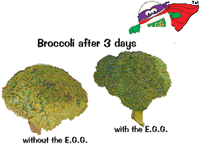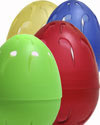| The
ethylene molecule is very reactive and is readily oxidized into a state that will
not do damage to produce. There are several ways that may be used to remove ethylene
from produce storage areas. One of the simplest and safest methods is to oxidize
it with potassium permanganate. (For those of you who, like me, enjoy chemistry,
a link to the reaction is given at the bottom of this page). This reaction
can remove ethylene to very low levels. Potassium permanganate (KMnO4) is used
in a number of familiar applications, such as in drinking water treatment systems.
Substrate
Since we have chosen to use potassium permanganate as our oxidizer, we need to
choose a way to make it the most available for reacting with the ethylene gas
in our refrigerator. We need a support medium that will allow the ethylene to
contact the oxidizer so it may be reacted away. Industry does this in several
ways, or course, but for the home refrigerator application we like the use of
natural zeolite. Zeolite is a pure form of volcanic ash that has a very high surface
area, providing an ideal substrate for the ethylene oxidation to occur.
Natural
zeolite is often used as an odor absorber and a humidity stabilizer in refrigeratores,
closets, and automobiles. The very high surface area traps odor molecules and
absorbs water when humidity is too high - releasing it back into the atmosphere
when it gets too dry. Of course, the zeolite used in the Ethylene Gas Guardian
serves those purposes, but its function as a support medium for removing ethylene
is its main purpose.
The
zeolite used in the E.G.G. is from an exceptionally high quality deposit. After
the crushing and grading of the zeolite, there are no fines and virtually no dusting.
The potassium permanganate is applied to the zeolite using a patented process
that lays the active chemical on the surface uniformly all the way to the center
of the zeolite. The resulting product has the highest reactive chemical, 6%, and
the best cationic exchange capacity of any in the industry.
Packets
The KMnO4 coated zeolite is then packaged in Tyvek packets that are water resistant,
but are highly permeable to ethylene. It contains the zeolite and prevents any
fines from getting out of the eggs and onto your produce. Although the contents
are not harmful, they can be colorful, making the produce less attractive to eat. |
|
 |
"Eggs"
A very important feature in the Ethylene Gas Guardian is its egg design.
In order to maintain the very low concentrations of ethylene necessary to protect
the produce in your refrigerator, there has to be a lot of contact between the
air and the potassium permanganate. If the zeolite packet were dropped into your
produce crisper as is, it would quickly find its way to the bottom of the drawer.
| The
vented egg design prevents cutting off the circulation that is required for effectiveness
from happening.
It is unlikely that anything could inadvertently fall
onto the egg that would totally restrict air flow. Ideally, the eggs should be
placed in separate drawers to further limit the possibility that restricted air
flow would reduce its effectiveness. By having two points of possible contact
between the ethylene in the air and the KMnO4 on the zeolite, the lowest possible
level of ethylene can be maintained. |
|  |
Time
for Replacement
The reaction between the ethylene and potassium permanganate
oxidizes the ethylene away and, or course, reduces the potassium permanganate
away, too. The amount of potassium permanganate available will last at least 3
months in most home refrigerators. After 3 months you should replace the E.G.G.,
or the packets inside the egg. Refill packets are available.
Don't
throw the spent zeolite away ! We
recommend that you put the spent zeolite on your plants. The zeolite is a natural
soil and the MnO2 provides trace minerals to the soil. Your plants will love it.
|



